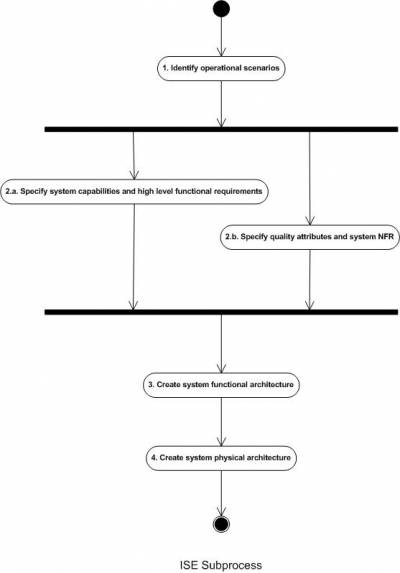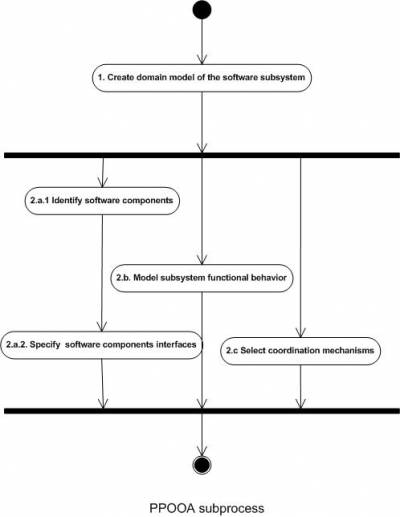mbse:ppooa
Fernandez ISE & Process Pipelines in OO Architectures (ISE&PPOOA)
Overview
- ISE&PPOOA (Integrated Systems Engineering and PPOOA) provides an integrated process and methods for systems engineering of software intensive mechatronic systems.
- The ISE part of the process includes the first steps of a systems engineering process applicable to any kind of system, not only the software intensive ones. The ISE subprocess integrates traditional systems engineering best practices and MBSE.
- The PPOOA part of the process emphasizes the modeling of concurrency as earlier as possible in the software engineering part of the integrated process.
- PPOOA is also an architecture framework for real-time software: http://www.iso-architecture.org/ieee-1471/afs/frameworks-table.html
- The integration between the systems engineering subprocess and the PPOOA software engineering subprocess is achieved by using a responsibility driven software analysis approach supported by CRC cards, a technique proposed in the OOPSLA´89 by Beck and Cuningham.
- ISE&PPOOA provides a collection of guidelines or heuristics to help the engineers in the architecting of a system.
- One of the project deliverables is the functional architecture representing the functional hierarchy using the SysML block definition diagram. This diagram is complemented with activity diagrams for the main system functional flows. The N square chart is used as an interface diagram in the shape of a matrix where the main functional interfaces are identified. A textual description of the system functions is also provided as part of the deliverable.
- Other of the deliverables is the physical architecture, representing the system decomposition into subsystems and parts using the SysML block definition diagram. This diagram is complemented with SysML internal block diagrams for each subsystem and activity and state diagrams as needed. A textual description of the system parts is provided as well. The heuristics used for the particular architecture solution are identified and documented.
- The software subsystem architecture is described in PPOOA using two views supported by one or more diagrams using UML notation. One view is the static of structural view and the other is the dynamic or behavioral view of the system. The system architecture diagram represents the system components and the composition and usage relations between them. Coordination mechanisms used as connectors are also represented. The system behavioral view is supported by UML/SysML activity diagrams representing an internal view of the flow of actions performed by the system in response to an event
- Bidirectional functional allocation between components and system responses modeled as activity diagrams is considered and tool supported
- ISE&PPOOA makes easy the architecture evaluation from time responsiveness characteristics
- ISE&PPOOA/Energy is the latest process of this MBSE method. ISE&PPOOA/Energy is used to deal with energy efficiency issues in industrial facilities. See the resources section for recent published papers dealing with examples of application.
Tool Support
- ISE&PPOOA MBSE methodology was created as tool- and vendor-neutral. Currently we are using diverse commercial SysML tools as it can be read in our articles and papers dealing with examples.
- Tool support for architecting software with PPOOA software architecture framework is provided via a free add-on for Microsoft Visio 2003 that can be requested to ise&[email protected]. This tool supports software architecture developing, documentation generation and the interoperability with other execution simulation and schedulability analysis tools (for example the Cheddar tool from the University of Brest)http://beru.univ-brest.fr/cheddar/
Offering/Availability
- Diverse courses dealing with ISE&PPOOA MBSE methodology and PPOOA architecture framework are offered here https://ppooa.com.es/training/
Resources and External References
- Fernandez, Jose L.(1998), ”An Architectural Style for Object-Oriented Real-Time Systems”, 5th International Conference on Software Reuse.Victoria (Canada). IEEE 1998.http://ieeexplore.ieee.org/document/685753/
- Fernandez, Jose L and Mason, Will. (2002), “A Process for Architecting Real-Time Systems”, 15 th International Conference on Software and Systems Engineering (ICSSEA), Paris,France. December 2002.https://www.researchgate.net/publication/239753313_A_Process_for_Architecting_Real-Time_Systems
- Fernandez, Jose L. and Martinez, Juan C. (2003), “Implementing A Real Time Architecting Method in a Commercial CASE Tool”, 16 th International Conference on Software and Systems Engineering (ICSSEA), Paris,France. December 2003.
- Fernandez, Jose L and Esteban, Eduardo.(2005), “Supporting Functional Allocation in Component-Based Architectures”, 18 th International Conference on Software and Systems Engineering (ICSSEA), Paris,France. December 2005.https://www.researchgate.net/publication/257827007_Supporting_Functional_Allocation_in_Component-Based_Architectures
- Fernandez Jose L and Marmol, Gloria.(2008), “An Effective Collaboration of a Modeling Tool and a Simulation and Evaluation Framework”. 18 th Annual International Symposium, INCOSE 2008. Systems Engineering for the Planet. Utrecht, The Netherlands. June 2008.http://onlinelibrary.wiley.com/doi/10.1002/j.2334-5837.2008.tb00896.x/full
- Monzon, Antonio and Fernandez, Jose L. (2009), “Deadlock Risk Assessment in Architectural Models of Real-Time Systems”, IEEE Computer Society Press : Industrial Embedded Systems (SIES 2009). IEEE Symposium on Industrial Embedded Systems 2009. Lausanne, Switzerland July 8 - 10, 2009. IEEE Computer Society Press, 2009, P. 181-190.http://ieeexplore.ieee.org/document/5196214/
- Garcia, Mario and Fernandez, Jose L.(2011), “A Case Study of the Application of Model Based Systems Engineering to a UAS”, Students Contest. AeroDays 2011. Sixth European Aeronautics Days. Madrid (Spain). March 30- April 1, 2011.
- Fernandez, Jose L.; Garcia, Mario; Garcia, Jesus and Gomez, Patricio.(2012), “La ingeniería de sistemas y su aplicación a un vehículo aéreo no tripulado”. (Spanish). Revista Dyna Ingeniería e Industria. Julio 2012. Vol 87-4. pp 456-466. http://dx.doi.org/10.6036/4574
- Fernandez, Jose L. (2012), “ An Integrated Systems and Software Engineering Process”. Tutorial. Aula Artigas. Industrial Engineering School. ETSII-UPM. Madrid (Spain). May 18, 2012.
- Monzón, A., Fernández, J. L. and de la Puente, J. A. (2012), Application of Deadlock Risk Evaluation of Architectural Models. Softw: Pract. Exper., 42: 1137–1163. doi: 10.1002/spe.1118
- Hernández Corbato, C. (2013), “Model-based Self-awareness Patterns for Autonomy”. PhD Dissertation. Industrial Engineering School. Madrid Technical University (UPM). Madrid (Spain). October 17, 2013.
- Fernández, J. L., Lopez, J. and Gomez, J.P. (2015), “Model Based Enginering of an Unmanned Aerial System”. The 20th International Conference on Reliable Software Technologies-Ada Europe 2015. 22-26 June 2015. Madrid (Spain).
- Hernández, C., Fernández, J.L., Sánchez-Escribano, G. Bermejo-Alonso, J. and Sanz, R.(2015), “Model-Based Metacontrol for Self-Adaptation”. The 8th International Conference on Intelligent Robotics and Applications. Portsmouth, UK. 24-27 August 2015. Springer, Lecture Notes in Artificial Intelligence, LNAI 9244. http://link.springer.com/chapter/10.1007/978-3-319-22879-2_58.https://books.google.es/books?id=UqxnCgAAQBAJ&pg=PA651&lpg=PA651&dq=ise%26ppooa&source=bl&ots=v13zPalu3Y&sig=u9QwI-WPj_mwXz6s04iXVGTXf8k&hl=es&sa=X&ved=0ahUKEwiK4-amvqnMAhWLXBoKHVJqDAwQ6AEIPzAE#v=onepage&q=ise%26ppooa&f=false
- Fernandez, J.L., Lopez, J. and Gomez, J.P. (2016),“Reengineering the Avionics of an Unmanned Aerial Vehicle”. IEEE Aerospace and Electronic Systems magazine. 31: 4, pp 6-13. doi: 10.1109/MAES.2016.150048. http://dx.doi.org/10.1109/MAES.2016.150048
- Fernandez, J.L. and Moreno, G. (2016), “MBSE for Engineering Students”, INCOSE International Symposium, Vol 26, Is 1. Edinburgh, 18-21 July 2016. http://dx.doi.org/10.1002/j.2334-5837.2016.00223.x
- Fernandez, J.L. and Moreno, L. (2017), “A Systemic Approach for Energy Efficiency. The Case of a Steam Generation Process”, 7th International Congress on Energy and Environment Engineering and Management (CIIEM7), 17-19 July 2017, Canary Islands (Spain).
- Hernandez, Carlos and Fernandez-Sanchez, Jose Luis. (2017),“Model-Based Systems Engineering to Design Collaborative Robotics Applications”. 2017 IEEE International Symposium on Systems Engineering (ISSE) Proceedings. Vienna (Austria). October 11-13.https://doi.org/10.1109/SysEng.2017.8088258
- Fernandez Sanchez, J.L. and Nicolas Serrano, D.(2018),“Ingeniería de sistemas y eficiencia energética. El caso de un proceso de pasteurización”,ieNeR´18, I Congreso Ingeniería Energética, 27 y 28 de Junio de 2018, Madrid (España).https://www.academia.edu/36953611/Ingenier%C3%ADa_de_sistemas_y_eficiencia_energ%C3%A9tica_El_caso_de_un_proceso_de_pasteurizaci%C3%B3n
- Fernandez, J.L. and Hernandez, C. (2019),“Practical Model-Based Systems Engineering”, Artech House,Boston, MA. ISBN:9781630815790.https://books.google.es/books?id=8VyzDwAAQBAJ&hl=es
- Fernandez, J.L. (2020), “An Introduction to the ISE & PPOOA approach to MBSE,” webinar April 29, 2020. MBSE Group-INCOSE UK Chapter. Slides are available at http://www.incosewiki.info/Model_Based_Systems_Engineering/Files/b/bd/ISE%26PPOOA_Methodology_Webinar_April_29_2020.pdf. Recording is available at https://www.youtube.com/watch?v=UVOLHBn8l90.
- Project Performance International (2020). “Systems Engineering Newsletter.” PPI SyEN 91 – 27 July 2020. https://www.ppi-int.com/ppisyen91/
- Fernandez,J.L. and Hernandez,C.(2020).“ISE&PPOOA a MBSE Methodology from System to Software Architecture.” INCOSE Webinar 145, November 18,2020. Recording and slides available at INCOSE website.https://www.incose.org/
- Fernandez, J.L., Martinez, J.A. and E. Diez. (2021),“Modeling the Mission Dimension. The Case of an Intravascular Medical Device,” INCOSE IW 2021, January 29-31, 2021. Slides available at OMG MBSE wiki.https://www.omgwiki.org/MBSE/lib/exe/fetch.php?media=mbse:incose_mbse_iw_2021:iw2021_lightning_round_mission_dimension_of_a_imd.pdf
- Garcia, A and J.L. Fernandez. (2021),“A Practical Example of the Process to Define a System Functional Architecture,” PPI SyEN 98 -24 February 2021.https://www.ppi-int.com/syen-newsjournal/ppi-syen-98/
- Fernandez, J.L., Martinez, J.A. and E. Diez-Jimenez. (2021),“Modeling the Mission Dimension. The Case of an Intravascular Medical Device,” PPI SyEN, issue 100, April 2021.https://www.ppi-int.com/wp-content/uploads/2021/04/PPI-SyEN-100-1.pdf
- Martinez, J.A. et al.(2021),“Model-Based Systems Engineering Applied to Trade-Off Analysis of Wireless Power Transfer Technologies for Implanted Biomedical Microdevices,” Sensors 2021, 21, 3201. https://doi.org/10.3390/s21093201
- Fernandez, J.L. and Garcia A. (2021). “Functional Architecture Made Simple with ISE&PPOOA MBSE Methodology,” webinar june 9, 2021,Gesellschaft für Systems Engineering e.V., webinar recording at https://youtu.be/OdDOaNfiabk.
- Fernandez, J.L. and Martinez J.A. (2021).“Applying Heuristics to Model the System Physical Architecture,” PPI SyEN issue 103, August 2021 https://issuu.com/ppisyen/docs/ppi_syen_103_aug_2021/s/13114644
- Martínez-Rojas, JA, Fernández-Sánchez, JL. Combining dimensional analysis with model based systems engineering. Systems Engineering. 2023; 26: 71- 87 https://doi.org/10.1002/sys.21646
- Martinez-Rojas, J.A.; Fernandez-Sanchez, J.L.; Fernandez-Munoz, M.; Sanchez-Montero, R.; Lopez-Espi, P.L.; Diez-Jimenez, E.; (2023) Model-based systems engineering approach to the study of electromagnetic interference and compatibility in wireless powered microelectromechanical systems, Systems Engineering, 2023, 1-14.https://incose.onlinelibrary.wiley.com/doi/10.1002/sys.21733
Return to List of MBSE Methodologies
mbse/ppooa.txt · Last modified: 2024/01/23 06:38 by joselfernandez



